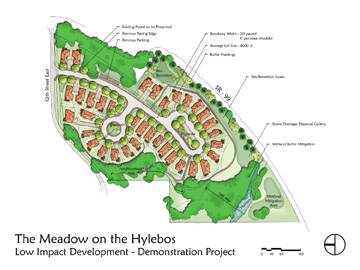

| Case studies | |||
| Kensington Estates, Pierce County, WA: The goal of this project was to redesign the plan for Kensington Estates, a 103-lot single-family development on 24 acres of poor Class C and D soils, using the Western Washington Storm Hydrology Model (WWHM) and applying LID technologies. WWHM is a continuous simulation model as opposed to the currently-used Pierce County single event model. Additional goals were to: |
 |
||
| (Len Zickler, AHBL) | |||
|
|||
| While this project has
not yet been built, a case study was done to demonstrate the projected
benefits of using LID design. The conventional design required a stormwater
detention pond of 270,000 cubic feet, while the LID redesign necessitated
a less than 55,000-cubic-foot pond. Other aspects of the LID redesign, such as increased open space and a continuous pedestrian circulation system, illustrate that sustainable designs can be just as livable, if not more so, than conventional neighborhoods. The lot sizes in the redesign are smaller than those of the original design (4100 square feet versus 7200 square feet), but still provide for adequate yard space. Moreover, these smaller lots helped make the public open space system possible. |
|||
| A cost analysis showed that the LID project would cost 20 percent less than the conventional design. Savings were associated primarily with the use of a smaller stormwater pond, but also related to reduced excavation and erosion control costs. The costs of road and utility construction were estimated to be the same or marginally higher due to the use of porous paving and cul-de-sac clusters for emergency vehicle access. For additional general cost information, see “Cost issues.” (Zickler 2002) | |||
Permeable Pavement Field Study, Olympia, WA: |
|||
| This study was conducted in an office parking lot in Olympia, WA. Eight parking stalls using four different permeable pavements were installed and the runoff from these was monitored, collected, and tested for chemical compounds. The four types of pavement tested were | |||
|
|||
| In addition, a control stall of conventional asphalt was built and monitored for comparison. | |||
| The results of the study showed that the use of the permeable systems did reduce runoff volumes and lessen peak discharge. The hydrologic responses of the systems were also influenced by storm characteristics and weather conditions. While the permeable paving systems were more expensive than conventional asphalt, reduced life cycle and maintenance costs may result in cost savings in the long run. Much of the benefit of impervious paving is clearer when looking at the ‘bigger picture.’ It reduces effective impervious area, which has a direct influence on downstream drainage systems. “This strategy of hydrologic and hydraulic disconnectivity can be used to control runoff and timing, reduce runoff volume, and provide water quality benefits.” (United States Environmental Protection Agency Office of Water 2000) | |||